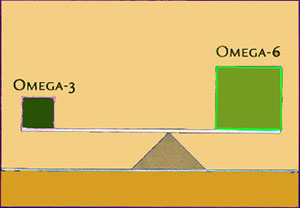| Back to Back Issues Page |
 |
|
Top Ways to Get More DHA and EPA -- Issue #44 March 15, 2014 |
~~~~~~~~~~~~~~~~~~~~~~~ IN THIS ISSUE:
~~~~~~~~~~~~~~~~~~~~~~~~
What is DHA and EPA?EPA and DHA are both essential Omega-3 fatty acids derived from ALA Omega-3 fatty acid. They are "essential" because the body does not manufacture them and we need to get them from the foods we eat.DHA is Docosahexaenoic acid and plays a vital role in the functioning of the human brain, eyes, heart, reproductive glands, nervous system and hormone receptors. It is very important nutrient for pregnant mothers because it is essential to the growth of the fetus and its brain development. Our brains are mostly composed of fat and 97% of the fatty acid components that make up our brain are DHA. DHA feeds our brain serious nutrients needed for proper neurological functioning and needs to be replenished on a regular basis through dietary sources. Cognitive illnesses such as Alzheimer's, depression, memory loss and Parkinson's have been associated with low levels of DHA in the brain tissue. EPA stands for Eicosapentaenoic acid and is a very important nutrient for controlling and reducing inflammation in the body because it is an important precursor to eicosanoids, molecules that regulate the inflammatory response.
DHA and EPA are both natural, anti-inflammatory Omega-3 acids and key nutrients needed to balance Omega-6 fatty acids and their pro-inflammatory effects that can lead to chronic inflammation in the body over time. It is important to try to meet the daily recommended EPA/DHA requirements of between 600-1000 mg. The easiest way to do this is through a concentrated oil supplement, but there are other ways to naturally boost your EPA and DHA levels and allow the body to absorb more from your supplements as well as from the foods you eat. Top Ways to Get More DHA and EPA1) Eat a more balanced mix of Omega-6 to Omega-3 fatty acids foods, following the 4:1 ratio rule.People who eat the correct proportions Omega-6 to Omega-3 are found to have a higher success rate at converting EPA and DHA naturally from the Omega-3 fatty acid ALA. Generally, EPA can more effectively be converted from ALA-rich foods than DHA. ALA is particularly abundant in green leafy vegetables, micro-algaes, chia seeds, flax seeds, hemp seeds, sacha inchi seeds, with small amounts available in seaweeds, walnuts and sprouts. The typical standard for Omega-6:Omega-3 is between a 4:1 or 1:1 ratio. This means that for the amount of Omega-6 foods you consume you would need to eat at least 1/4 of that amount in Omega-3's. This has shown to help the conversion of ALA to EPA/DHA in some individuals. Omega-6's are found in abundance in saturated fats and trans fatty processed foods as well as meat protein, eggs and dairy products. In addition, olives, avocados, and most nuts and seeds (aside from the ones mentioned) are substantially higher in Omega-6 fats. 2) Drink more green juices and smoothies. Dark green leafy vegetables are high in ALA fatty acids, but they need to be consumed in large quantities to effectively balance the Omega-6 levels. Two easy ways to do this, if you're not into eating large bowls of salad everyday, is to make green juices and smoothies on a regular basis. Juicing a head or two of greens with cucumber, celery and apple is an excellent way to get an abundance of ALA. Green smoothies can be made by blending greens like kale or collard with frozen banana or other sweet fruits and chia seeds. Micro-algaes like blue-green algae or chlorella can also be added for extra omega fats that have shown to convert to EPA and DHA, as do leafy greens, when the proper proportions of Omega-6 and Omega-3 are consumed. 3) Eat less processed foods high in trans fats. Exercise regularly and avoid excessive alcohol consumption. The other thing that inhibits the conversion from ALA to DHA/EPA is a diet high in saturated animal fats and trans fats, like hydrogenated oils. Omega-6 fats, like AA (pro-inflammatory), are especially concentrated in hydrogenated, refined vegetable oils such as corn oil, cottonseed oil, sunflower oil, safflower oil, peanut oil and sesame oil. They are often found in fast foods as well as packaged foods to help them retain a shelf life. In addition, maintaining a regular exercise program with minimal alcohol consumption is the way to go for transferring and sustaining these omega fatty acid nutrients. Drinking alcohol on a regular basis is shown to significantly reduce DHA levels and helps to cause depression. 4) Supplement the diet with a high quality algae, fish or krill oil. Depending on the situation, additional supplementation may be required for you to achieve optimal DHA and omega fatty acid balance. There are several fish, krill and algae based oils to choose from that we would recommend. Algae oils are a better alternative for those following a vegan diet and they also have potentially less heavy metals and other toxins that are common in sea life higher on the food chain. However, you can also find high quality krill and fish oils that are purified and tested for various contaminants. 5) Raw fish, especially wild caught salmon. The most common source of DHA Omega-3 encouraged by the mainstream medical and health community is, without a doubt, cold water fish. Although fish can be high in DHA, which it gets from eating algae, the beneficial oils are destroyed when it is cooked at high temperatures. It is therefore best to eat "raw" fish for optimal EPA/DHA uptake. In addition, fish also comes with a host of potential toxins and heavy metals that are not good to take in on a regular basis. So, you might want to keep these things in mind if you are using it as a main source of this essential 3 fat. (For more on omega fatty acids click here.) DHA and EPA SupplementsOvega-3 - Amerifit Nutrition's, 500mg 60 gelsOvega-3 oil is one of our personal favorite omega oil supplements. It is a vegetarian and vegan form of DHA & EPA, obtained from an uncontaminated natural algae source instead of fish. With 500 mg of total Omega-3s, Ovega-3 provides the same nutritional benefits of traditional fish oil supplements. Most people think that fish are the original source of DHA and EPA, but it's really the algae they eat that naturally contains these important Omega-3s. Ovega-3 has gone directly to the source and bypassed the fish. Not only that, this omega oil is free of PCBs and mercury because it is sourced from plants that are grown outside of ocean waters. Ovega-3 Oil Dr. Fuhrman’s DHA+EPA Purity This liquid oil product is 100% vegan sourced from lab-grown algae with no environmental contaminants and is a certified as a pharmaceutical grade oil supplement. It contains both EPA and DHA, with a few drops delivering over 250 mg of Omega-3 (172 mg DHA, 82 mg EPA). Dr. Fuhrman’s DHA+EPA Purity Omega Zen 3 + EPA, 40 caps - NuTru Omega-Zen 3 is an seaweed based oil and also great for strict vegans. It contains both EPA and DHA. It comes in soft gel caps and is our second favorite next to Ovega-3. O-Mega-Zen3 + EPA is in a soft vegan capsule made from natural marine plant seaweed sources. This product does not contain any animal material and contains 200mg DHA (Docosahesaenoic Acid) and 100mg EPA (Eicosapentaenoic Acid). Omega Zen 3
Until our next issue... May you thrive, prosper and evolve in the best of ways!
SUBSCRIBE TO OUR:
All information in this ezine is the personal view of the author and is for educational purposes only and not intended as medical advice, diagnosis or prescription. This information has not been evaluated by the FDA and is not intended to cure or prevent any disease.
|
| Back to Back Issues Page |







